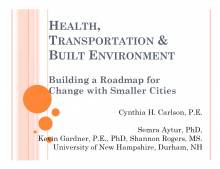We are pleased to announce an exciting new alliance between Active Living Research and GP RED to co-host and coordinate...
Health, Transportation & Built Environment: Building a Roadmap for Change with Smaller Cities

Presentation at the 2011 Active Living Research Annual Conference
Background:
Municipal governments, regional planners, and local public health experts are stretched to their limit with their primary job foci. Important issues such as reducing energy usage, maintaining infrastructure cost-effectively, and supporting good health in their community are important interrelated issues that are often added on top of the daily tasks of running a city. Small cities are of particular interest as 94% of municipal governments represent populations of 25,000 people or less, and all but 1.1% of municipal governments in the United States represent populations of less than 100,000. Working together to find local solutions for smaller cities to address these issues represents a synergy that may catalyze action.
Researchers have suggested that as the baby boomers age, it would be wise to plan for “smart reuse” of existing land uses, including improved efficiency of built environment design for reduced need to drive. Retrofitting existing neighborhoods and communities to remove barriers to walking and allow residents to choose walking as a mode of transportation has the potential to both stabilize energy used for transportation and transportation infrastructure and provide physical activity for improved health, shifting the energy used for transportation from cars to people.
Objectives:
This study brings together community-based research, an interdisciplinary team approach, and multi-level modeling to investigate how community design impacts transportation behavior in the context of smaller, northeastern cities. This work highlights the influence that neighborhood-level built environment characteristics have on personal transportation decisions in the study area.
The main objectives of the study are to:
• Examine associations between neighborhood-scale built environment characteristics and personal transportation decisions,
• Examine whether socio-demographic factors, such as age and income, influence decisions to walk in different neighborhood contexts, and
• Examine how the built environment might potentially be manipulated to remove any real or perceived barriers to walking within neighborhoods.
Methods:
Municipal employees (representing the planning, health, and economic development departments) of two smaller New England cities (Manchester and Portsmouth, NH) were convened, along with regional planners and an interdisciplinary team from academia (representing public health, civil engineering, natural resources, transportation, and resource economics). Together, the group discussed how best to gather data related to determining the barriers to walking across neighborhood types and developed an approach that would meet the disparate data needs represented.
Ten neighborhoods of varying design, connectivity, proximity to services, and average income were selected in each of the cities for a total of twenty neighborhoods studied. One hundred residences were randomly selected to receive the survey in each of the neighborhoods; questions asked included age, income, education, self-reported health, walking destinations, and maximum time willing to walk to a destination. Information about the built environment within the neighborhoods was determined by field visits and published GIS data. Data analysis included multi-level modeling to account for the within-neighborhood clustered design of data collection.
Results:
Of the demographic variables, only younger age was consistently associated with an increased number of places to which respondents reported walking. Self-reported health, income and education were not significant in the presence of age.
Of the built environment variables, the presence of sidewalks and intersections (3 or more legs) were positively associated with the number of places survey respondents reported walking. Even when a proxy for neighborhood self-selection was included in the models, sidewalks, intersections (3 or more legs), and age remained significant. However, the neighborhood presence of local destinations was not significantly related to the number of places residents reported walking.
Conclusions:
Working together with the people for whom the results were intended allowed for use of a greater network of contacts for project development and implementation, which helped greatly. Involving municipal and regional authorities throughout the project increased the chances that results ultimately will be implemented and will reach residents, and increased communication between the authorities themselves.
Presence of sidewalks and intersections were found to be associated with the number of destinations respondents reported walking. Municipalities that would like to increase walking for public health or energy use reduction should investigate improving the condition and availability of sidewalks in neighborhoods, increasing connectivity of pedestrian ways where possible, and improving safety and perceived security at intersections.
Age appeared to be the most important demographic factor in decisions to walk, more important than self-reported health or income. Helping the elderly, as they age in place, to continue to feel secure through improved walking surfaces and walking environments could become a focus of municipal programs and initiatives.
Support:
The authors appreciate the support of the University of New Hampshire’s Sustainability Fellowship Program through UNH’s Environmental Resources Group. The research described in this paper has been funded in part by the United States Environmental Protection Agency (EPA) under the Science to Achieve Results (STAR) Graduate Fellowship Program. EPA has not officially endorsed this publication and the views expressed herein may not reflect the views of the EPA.
STAY UP TO DATE
RECENTLY ADDED TOOLS & RESOURCES
MOVE! A BLOG ABOUT ACTIVE LIVING
The "Active Living Conference" aims to break down research and practice silos and...







